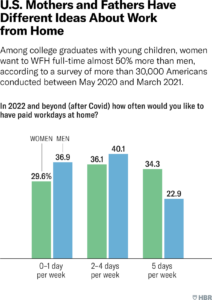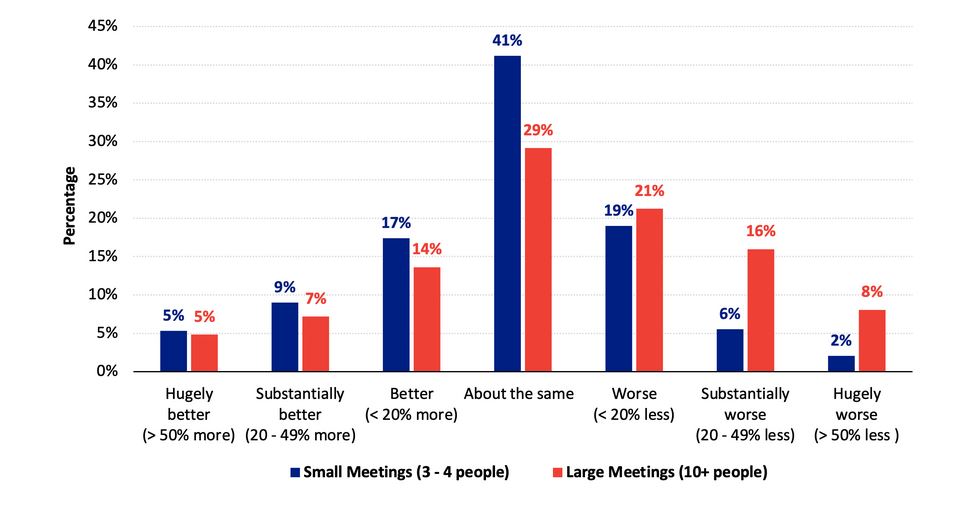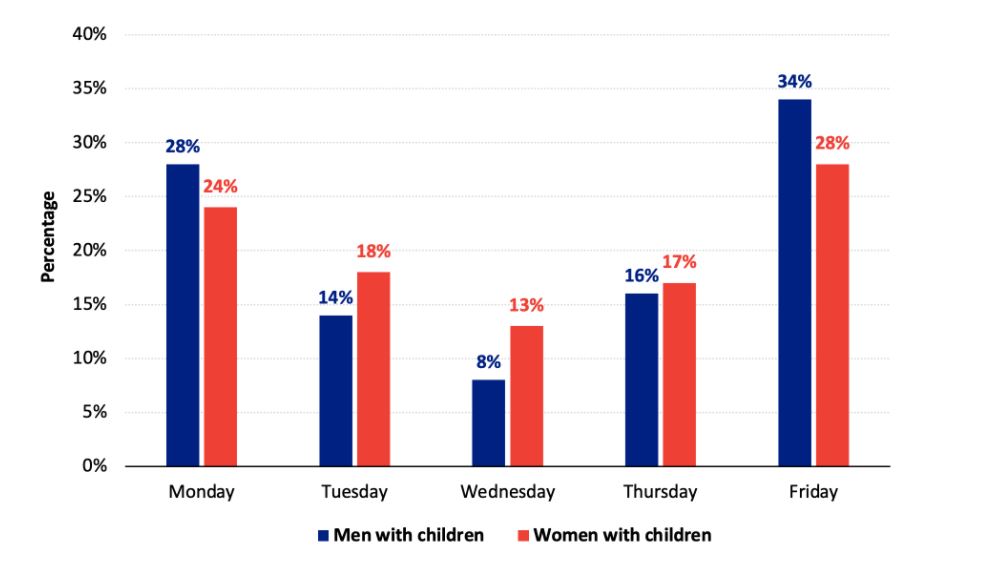Employers looking to have their teams return to the office are facing an uphill battle. Over 50% of respondents to a survey done by Harvard Business Review [1] shared that they would like to have two or more workdays from home per week and only 10% of respondents are looking for just a single work from home day per week. The 10% group would like to extend their weekend with WFH on either a Friday or Monday. The survey found that only 32% of respondents want to work from home full time, which means that most people still want to have at least a couple of days per week in the office.
Accommodating WFH
Can employers accommodate everyone’s preferred work remote preferences?
Dan Price, CEO of Gravity Payments, asked and answered [2] with his thoughts on this topic:
I asked our staff how they want to work. Just 7% wanted to go back to the office full time, while 31% wanted an office-remote hybrid and the remaining 62% wanted to work from home all the time. So I told them: sounds great. Do whatever you want.
Dan Price
In addition to believing in location flexibility, Price also allows his employees to pick their own hours.
Price’s flexible approach sounds like a logical conclusion. Price is an employer who views his employees as adults, mature enough to make their own choices. He also shares that while his teams were remote over Covid, the company had record setting sales number. Based on all of the information Price presents, his decision seems like a solid plan for his business.
The data that Price shared is startlingly similar to the findings we shared earlier from HBR. With two matching studies, it seems like we have enough insights for other leaders to leverage. Should other companies follow Price’s lead on accommodating everyone’s WFH preferences?
Surprisingly, adding more granular data into the decision process tells us that Price is not doing his team any favors with his setup.
Also Read: The Unbalanced Work/ Life Balance
Gender disparity with WFH
One big problem is that women lose.
Why?

A study done between March 2020-2021 across 30,000 college graduates with young children found that women were close to 50% more likely to want to work from home full time. We also found that women log roughly 39 hours per week of unpaid work from home time, while men spend roughly 19 hours per week. [3] We layer that data with information from a Stanford study [4] and conclude that WFH employees, in a hybrid work environment, have a 50% lower rate of promotion after 21 months, despite a 13% performance increase. Working women are 48.6% of the labor force. [5]
This data indicates that following Price’s model will have more men being promoted and is a professional step backwards for women. It also is likely to reduce the success of the company overall. Credit Suisse published a report [6] stating that companies with at least 15% female senior management were 50% more profitable than companies with less than 10% female senior management. Keeping women engaged and motivated has been proven to increase a company’s success.
I think research shows that groups that are diverse with respect to gender, with respect to ethnicity, actually engage in better decision making.
Janet Yellen
The ECB Podcast “A Conversation about female empowerment, an inclusive recovery and transatlantic cooperation”
What’s next? Let’s analyze available data and see why people want to come into the office and if we can suggest a model where everyone is in the office at least one day per week, but has the flexibility to choose the day they’d like to come in.
Meetings
One of the main reasons for returning to the office is for face-to-face meetings and collaboration. Price feels differently about the need for in-person meetings. He recently shared on LinkedIn his thoughts on why WFH meetings create a safer place for communication.
Remote work also helps with the bias that star employees are the ones who contribute most in meetings. Often times they are just the ones that like to talk the most. People who keep to themselves are usually listening more intently than anyone and have valuable things to share if you get them into a more comfortable space.
Dan Price
Are large meetings more effective virtually or in-person?

It’s true that data suggests [7] that not all meetings benefit from being in person. Virtual small meetings, with anywhere between 2 and 4 attendees, are scored as being as efficient as in-person meetings. Part of the success of small meetings is that video conferencing tools have enough room on the screen to show each person. With enough real estate for a visual connection, attendees can interact. The study also found that people in small meetings didn’t need to mute themselves as frequently.
Only 26% of respondents reported that large virtual meetings were an improvement over large in-person meetings. 46% of respondents found large meetings anywhere between “worse” and “hugely worse” when virtual. The study demonstrates that Price’s reasoning for remote meetings going well actually had the opposite impact for many respondents. One of the key problems reported with large virtual meetings was that a couple of vocal people could hijack the whole meeting. It seems that large meetings, whether in-office or remote, have this same challenge. This data point would easily be corrected with a well planned meeting.
In MeetingFull, a meeting agenda is created on a per topic level, with an option to designate a subject matter expert for each topic. Each topic is also allocated an estimated amount of time. During the meeting all attendees have the agenda and objectives visible, with a friendly clock keeping the meeting on track. This carefully designed workflow helps avoid a scenario of unclear expectations of a meeting.
Another challenge listed with large remote meetings was difficulty with finding side conversations during a meeting. People contributing to a meeting have too many places to post their information (Zoom chat, Slack, Teams, Meet, email, etc.) leading to difficulty accessing side communications and information. People also have too many options for how to share if they need to step away for a moment. MeetingFull addresses both of these communication scenarios.
MeetingFull has a collaborative notes editor, where all attendees can add information in real time. MeetingFull also has a full attendee management feature. The attendee management feature is an elegant way to eliminate disruption and allow someone to indicate that they’ve stepped away. It helps avoid the meeting organizer trying to teach you how to turn off your mute when you’re really not there at all!
MeetingFull can solve the process issues with meetings. Though VR may eventually make you feel like you’re in the same room as your colleagues, nothing can replace the value of human interaction and the communication an in-person interaction builds.
Uneven distribution of office attendance
Can Price change his model to have a minimum of in-office workdays, with every employee picking their most convenient day(s)?

Returning to the office will be hard, Nicholas Bloom, Paul Mizen, Shivani Taneja 15 June 2021
The chart above tells us the preferred work from home days for parents. The days closest to the weekends are most popular for wanting to work from home. The chart indicates that Wednesday is the ideal day for coming into an office, since the smallest number or respondents chose it as a WFH day. The number is still not perfect since 13% of women, and only 8% of men, chose Wednesday as WFH. Companies would need to be able to accommodate office space for the majority of their teams on a Wednesday, and have those desks remain empty on a Monday and Friday.
Price’s approach to allowing everyone to pick their own WFH schedule creates a fragmented workplace. To help his employees thrive, a hybrid work week is advised. A team would have two or three days where they work from home, have quiet time and only have meetings with a few attendees. All large meetings, company events and other activities would be planned for the remaining days when a team is in the office. For this hybrid model to work, cross team and department plans will need to be carefully designed. MeetingFull helps people gain deep insights into their work network and lets people understand who they meet with most frequently across the organization. This data is key to properly planning based on number of attendees.
Let’s aim to do hybrid the right way. Flexibility is here to stay and it can align with success. If you build your hybrid schedule thoughtfully you’ll have smarter, happier teams and, ultimately, that’s what makes organizations successful.
See you in the office next Wednesday!
References
- Don’t Let Employees Pick Their WFH Day – Harvard Business Review ↩
- Is your boss ending remote work? As a CEO, let me tell you why they are wrong – The Guardian ↩
- The ECB Podcast ↩
- Does Working From Home Work? Evidence From a Chinese Experiment – Stanford ↩
- Women’s Labor Force Participation – Status of Women Data ↩
- 100 Women: Do women on boards increase company profits? – BBC ↩
- Returning to the office will be hard – voxeu ↩






